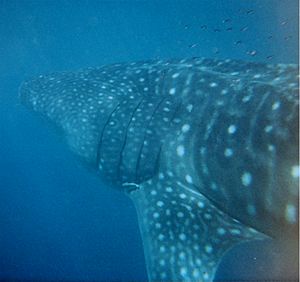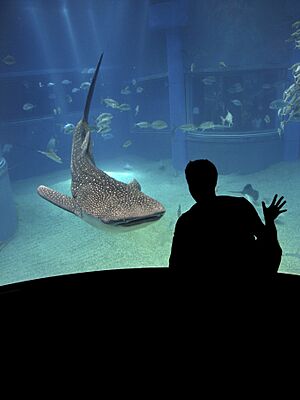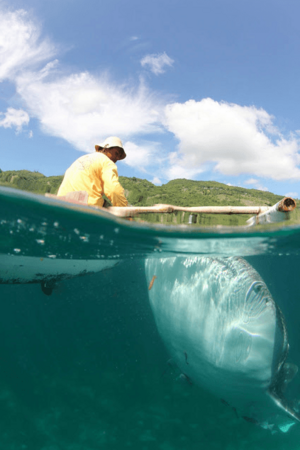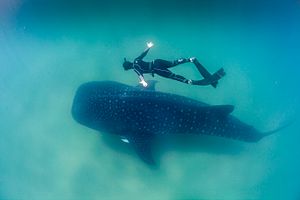Whale shark facts for kids
Quick facts for kids Whale shark |
|
|---|---|
 |
|
| Whale shark in the Andaman Sea around the Similan Islands | |
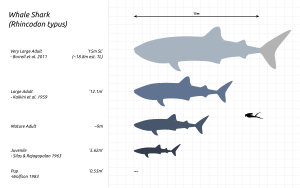 |
|
| The size of various whale shark individuals with a human for scale | |
| Conservation status | |
| Scientific classification | |
| Genus: |
Rhincodon
|
| Species: |
typus
|
 |
|
| Range of whale shark | |
| Synonyms | |
|
|
The whale shark (Rhincodon typus) is the biggest shark in the world. It's a type of shark that eats tiny plants and animals by filtering water. These amazing creatures can grow up to 12 meters (about 40 feet) long and weigh as much as 47,000 pounds!
You can find whale sharks in all warm tropical and temperate seas around the world. The only major sea where they are not found is the Mediterranean Sea.
Contents
Whale Shark Features
The whale shark has a smooth body shape and a wide, flat head. Its mouth is very large and is almost at the very front of its snout. The gill slits are also huge and work like special screens to filter food from the water.
The first dorsal fin (the one on its back) is much bigger than the second one. The caudal fin (tail fin) looks like a crescent moon in adult whale sharks. In younger sharks, the upper part of the tail is longer than the lower part.
Unique Patterns and Colors
Whale sharks have a special "checkerboard" pattern. They have light spots and stripes on a dark background. Their top side can be grey, blue, or brown. Their belly is white. Scientists are not sure why they have this unique pattern. Some think it helps them blend in with the ocean floor.
Size of Whale Sharks
Whale sharks can reach lengths of about 12.3 meters (41 feet). They can weigh up to 21.5 tonnes (47,000 pounds). Some people believe that certain whale sharks might grow even larger, possibly up to 20 meters (67 feet) long! The smallest free-living whale sharks are about 55 cm (21.7 inches) long. Whale sharks become adults when they are about 9 meters long.
Where Whale Sharks Live
Whale sharks live in many different parts of the world. They are found in all warm tropical and temperate seas, but not in the Mediterranean Sea.
You can find them in the Atlantic Ocean, from New York down to central Brazil. They also live from Senegal to the Gulf of Guinea. In the Indian Ocean, they are found everywhere, including the Red Sea and the Arabian Gulf. In the Pacific Ocean, they swim from Japan to Australia, near Hawaii, and from California to Chile.
Whale sharks prefer warm waters, usually between 21-30 °C (70-86 °F). They often swim far from shore. However, they sometimes come close to land, even entering lagoons or coral atolls. These sharks can also dive very deep, sometimes more than 700 meters (2,300 feet).
Who Hunts Whale Sharks?
Adult whale sharks do not have any natural predators. This means no other animals regularly hunt them. However, young whale sharks have been found in the stomachs of Blue sharks and Blue marlin.
Whale Shark Behavior
Even though whale sharks are huge, they are very gentle. Divers often swim near them and sometimes even hold onto their tails for a ride. The whale sharks usually do not attack.
It's important for divers to be careful. Getting too close could mean getting accidentally sucked into the shark's feeding system. Also, whale sharks can accidentally bump into small boats. For the sharks, hitting large boats can cause serious injuries.
How Whale Sharks Eat
The whale shark is one of only three known filter-feeding sharks. The other two are the basking shark and the megamouth shark. Whale sharks mostly eat plankton and nekton. This includes tiny crustaceans, schools of fish, and sometimes even tuna and squids. They might also eat tiny plants called phytoplankton and larger algae.
Unlike many other filter feeders, whale sharks don't just swim slowly forward to eat. They use a special suction method to pull in a lot of water. This helps them catch more plankton than other filter feeders. You often see whale sharks feeding in a vertical position, with their head near the water's surface. They also eat krill and the larvae of Christmas Island red crab.
Whale Shark Life Cycle and Reproduction
Scientists don't know much about how whale sharks mate or give birth. It's hard to study them because they are so big and not many live in aquariums.
However, it's thought that female whale sharks can have up to 300 pups at one time. This is many more than most other shark species. But only a small number of these young sharks survive to become adults. Scientists believe whale sharks don't start mating until they are about 30 years old. They can live for a very long time, from 70 to 100 years!
Whale Sharks and People
In the past, people didn't fish for whale sharks much. Now, commercial fishing for them is limited. But there's a growing demand for their meat. In Taiwan, about 100 whale sharks are caught each year. Their meat sells for high prices there. This has led to more whale sharks being caught in recent years.
Fishing for whale sharks also happens in the Philippines, especially in the Visayas and Mindanao areas. This provides food for local fishing communities. Whale shark fins are sold in places like Hong Kong. Sometimes, whale sharks are accidentally caught off the coast of India. Their meat might be eaten, and their liver oil is used to waterproof wooden fishing boats. The oil is also used for shoe polish and as a treatment for some skin diseases. Whale shark fins are also sold in India.
Sometimes, whale sharks are seen as a sign that there are many plankton-eating fish in the water. These fish can then attract more valuable species, like tuna. Whale sharks have been kept in aquariums in Japan. But their huge size and special diet make them difficult to keep. Some places where whale sharks are often seen are becoming popular spots for tourist activities.
How Whale Sharks Act Around Divers
Despite their size, whale sharks are not dangerous to humans. They are gentle fish. Sometimes, they even let swimmers hold onto them for a ride. However, shark scientists and people who work to protect sharks do not encourage this. It can disturb the sharks. Younger whale sharks are playful and can interact with divers. Photographers like Fiona Ayerst have taken pictures of them swimming close to people without any danger.
Divers can see whale sharks in many places around the world. Some popular spots include the Bay Islands in Honduras, Thailand, Indonesia, the Philippines, the Maldives, the Red Sea, and Western Australia. They are also seen in Taiwan, Panama, Belize, Mozambique, South Africa, the Galapagos Islands, Saint Helena, Isla Mujeres in the Caribbean Sea, and parts of Mexico. Other locations include the Seychelles, West Malaysia, islands off eastern peninsular Malaysia, India, Sri Lanka, Oman, Fujairah, Puerto Rico, and other parts of the Caribbean. Young whale sharks can be found near the shore in the Gulf of Tadjoura, near Djibouti.
Protecting Whale Sharks
Scientists don't have a clear number for how many whale sharks there are globally. The IUCN lists the species as endangered. This is because of fishing, accidental catches, and being hit by boats. Their long lifespan and late age of becoming adults also make them vulnerable.
In June 2018, New Zealand's Department of Conservation called the whale shark "Migrant" with the note "Secure Overseas." This means they migrate through New Zealand waters but are safe in other places.
The whale shark is also protected under the CMS Memorandum of Understanding on the Conservation of Migratory Sharks. In 1998, the Philippines banned all fishing, selling, importing, and exporting of whale sharks for business. India followed in May 2001, and Taiwan in May 2007.
In 2010, the Gulf of Mexico oil spill released a lot of oil into the sea. This happened in an area where many whale sharks are seen. Whale sharks were unable to avoid the oil slick, which was on the surface where they feed. No dead whale sharks were found after the spill.
In 2003, the whale shark was added to Appendix II of the Convention on International Trade in Endangered Species of Wild Fauna and Flora (CITES). This helps control the international trade of live whale sharks and their body parts. Sadly, hundreds of whale sharks are still killed illegally each year in China for their fins, skin, and oil.
Whale Sharks in Aquariums
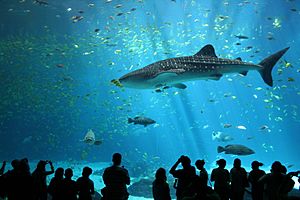
Whale sharks are popular in the few public aquariums that keep them. But their huge size means they need a very large tank. They also have special feeding needs. Their size and importance have led to some people being against keeping them in captivity. This is especially true after some whale sharks died early in aquariums. Also, some Chinese aquariums keep them in tanks that are considered too small.
The first time a whale shark was kept in captivity was in 1934 in Japan. It lived for about four months in a netted-off natural bay. The first attempt to keep them in an aquarium was in 1980 by the Okinawa Churaumi Aquarium in Japan. Since then, several whale sharks have been kept at Okinawa. Most were caught accidentally in fishing nets. Some were already weak when caught. Some were released, but many did not survive long at first. Over time, aquariums learned how to care for them better. Now, some have lived for a long time in captivity. The record for a whale shark in captivity is one that has lived for over 26 years at the Okinawa Churaumi Aquarium. After Okinawa, the Osaka Aquarium also started keeping whale sharks. Much of what we know about keeping them in aquariums comes from these two places.
Since the mid-1990s, other aquariums in Japan, South Korea, China, Taiwan, India, and Dubai have kept whale sharks. Some have kept them for years, while others only for a short time. A whale shark at Dubai's Atlantis, The Palm, was rescued in 2008. It had many scrapes on its fins. After getting better, it was released in 2010, having lived 19 months in captivity. The Marine Life Park in Singapore had planned to keep whale sharks but changed their mind in 2009.
Outside of Asia, the only place that has kept whale sharks is the Georgia Aquarium in Atlanta, United States. It's hard to bring the sharks there because of the long travel time (28 to 36 hours). The Georgia Aquarium currently has two male whale sharks, Taroko and Yushan, who arrived in 2007. Two earlier males, Ralph and Norton, died in 2007. Trixie died in 2020, and Alice died in 2021. The whale sharks at Georgia Aquarium were all brought from Taiwan. They were taken from the number of sharks allowed to be caught for food. Taiwan stopped this type of fishing completely in 2008.
Whale Sharks in Culture
In Madagascar, whale sharks are called marokintana. This means "many stars" in Malagasy. It refers to the star-like markings on the shark's back.
In the Philippines, they are called butanding and balilan. The whale shark is even shown on the back of the Philippine 100-peso bill. By law, snorkelers must stay at least 4 feet away from the sharks. There are fines and even jail time for anyone who touches them.
Whale sharks are also known as jinbei-zame in Japan. This is because their markings look like patterns on a traditional Japanese summer clothing called a jinbei. In Indonesia, they are called gurano bintang, and in Vietnam, they are called ca ong (which means "sir fish").
The whale shark is also on the latest 2015–2017 edition of the Maldivian 1000 rufiyaa banknote. It is pictured alongside the green turtle.
Related Topics
Images for kids
See also
 In Spanish: Tiburón ballena para niños
In Spanish: Tiburón ballena para niños



